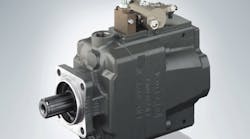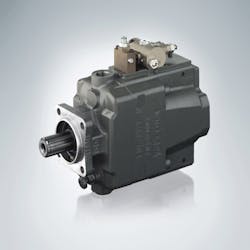They are designed for high pressure and high volume, and offer long life cycles, and high efficiency and control accuracy. For easy installation, they are directly attached to the vehicle’s power takeoff (PTO) with an SAE flange. For a modular design, the pump comes with a wide variety of controls and flanges with options for connecting additional pumps to the thru shaft. A 5-in. wide built-in performance controller protects against overloading the utility vehicle’s transmission
These axial piston pumps are suitable for usage in construction machines, concrete pumps, public transport and utility vehicles, waste disposal trucks, cranes, forestry vehicles and many other machines. They are suitable for load-sensing systems, where hydraulic consumers with different pressure levels and/or variable volume flows have to be supplied. Load-sense controls enable the hydraulic solution to support the energy efficiency of mobile machines and compliance with such emission regulations as Tier 4 and Euro 6.
HAWE Hydraulics North America, (980) 207-5637, www.hawehydraulics.com
V60N-130 is the newest of the V60N series of axial piston pumps, featuring four sizes with displacement volumes up to 8 in.3/rev, working pressures of up to 5800 psi and peak pressures up to 6500 psi. All built with swash plates, they provide the required displ


